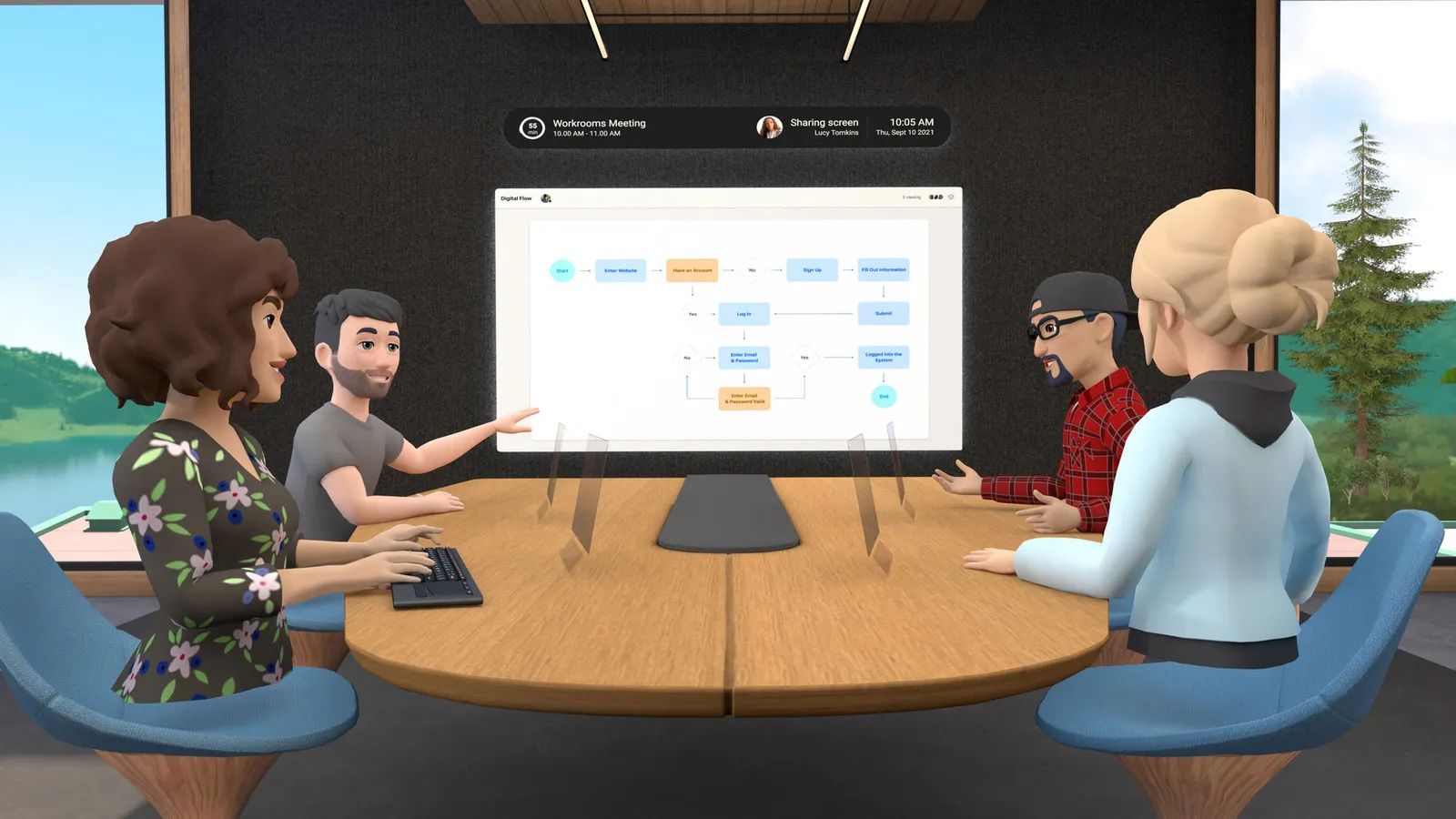
Can holograms and avatars replace Zoom video calls?
Few things strike fear in the hearts of millions of workers quite like the phrase, Let’s hop on a quick Zoom call.
After months of sitting in front of the camera, looking at colleagues in Brady Bunch-style boxes, workers are tired of video meetings – and tired from them, too. Although virtual meetings are, for most office jobs, a necessary evil, they’re also a drain on our energy and sense of connection, and, in some instances, even contribute to workplace inequality.
For some, the impending return to office means screens will finally be replaced by long-forgotten conference tables. Most workers, however, will return to a new hybrid and remote ecosystem where screens continue linking employees across the country.
So, is it back behind tiny cameras we go, forever?
Perhaps not. On 19 August, Facebook announced its new technology, Horizon Workrooms, which uses virtual reality headsets to gather colleagues as avatars inside of a simulated meeting room. The company is betting that strapping on a VR headset could not only help us get out of dreaded Zoom calls, but re-create the alchemy of working together in person.
Facebook’s approach is one of the boldest – if not simply the loudest – twists yet on the status-quo video call, rife with problems we haven’t managed to crack. Could holding meetings in the “metaverse”, or embracing other similar solutions, give us a break from what we hate most about Zoom calls? Or is it more likely that we wind up with a headache and a bout of vertigo instead?
Working in the ‘metaverse’
‘Disruption’ is an over-used tech buzzword, the world of virtual meetings really needs disrupting. Video meetings are a physical drain, they can be a social minefield and on a grand scale, they don’t work as well as in-person gatherings. This is due in part to how hard it is to virtually replicate the most crucial piece of in-person meetings, which is how we read others: video conferencing can inhibit our minds’ ability to process discrete movements and body language. Simply, we don’t gesture, move or convey emotions as effectively on screen, nor do we analyse them as well, either.
This isn’t an easy problem to crack – at least not with the technology we’re used to – which is where Facebook’s VR slots in.
 With Horizon Workrooms, users wear a virtual-reality headset and gather together in a meeting room to join colleagues' avatars
With Horizon Workrooms, users wear a virtual-reality headset and gather together in a meeting room to join colleagues' avatars
Workrooms is part of Facebook Horizon, the company’s VR metaverse, which has been used primarily for gameplay, until now. To get to their Workroom, users strap on a VR headset, set up an avatar and are greeted with a virtual desk. A home screen projects a daily calendar as well as the meeting rooms users can join – spaces with pastel walls, ample ‘natural’ light and floor-to-ceiling windows with a beautiful view of a digital horizon. Users can change conference tables to accommodate different kinds of meetings: there’s a small table for one-on-ones, half-circle tables for presentations and even a university-style lecture hall with raked seating. Crucially, as meetings happen, avatars’ gestures mirror the user’s real-life movements, theoretically re-recreating the nuanced body language lost over video calls.
Facebook isn’t the only company attempting to disrupt virtual meetings as we know them. American technology futurist Cathy Hackl points to hologram-style tech, which she says has been around since “at least the early 2000s”. Canada-based ARHT Media launched a 3D display system that can place users into meetings virtually. US company Spatial, another tech start-up, facilitated holographic-style meetings via Facebook's Oculus Quest headsets.
And in March 2021, Microsoft launched an augmented- and virtual-reality workroom tool called Microsoft Mesh. Mesh is in early stages but includes both actual holograms and what the company calls “holoportation” – a virtual rendering of your actual self in a digital space.
See you in VR?
These science fiction-esque alternatives are well and good, but can they actually bypass the inefficacy (and misery) of video meetings – and do so without creating a whole new set of challenges?
“Having experienced Horizon Workrooms, I would say it’s a very interesting, useful tool,” says Hackl, however, the objective of the metaverse isn’t “necessarily about creating a virtual world that replaces our current world. It’s about building on top of our world with digital content”.
Wasson cautions against underestimating the efficacy of Zoom, and undervaluing how much of a breakthrough the technology really is
This can be especially appealing for younger generations. “They tend to be very familiarised with gaming in some way, spending time in virtual worlds.” As far as work is concerned, metaverse-centred solutions like Horizon Workrooms may offer a secondary, safe place for colleagues to meet and collaborate – all without having to worry about Zoom etiquette or personal appearance, but Hackl doesn’t think the tools will have immediate universal appeal. One of her prior employers used Spatial to host sales calls. “I would be in my office at home and see holograms of 10 of my colleagues. The regular consumer isn’t doing that necessarily.”
First, the barriers to entry may simply be too high for companies, big and small. For Horizon Workrooms, specifically, headsets are expensive for individuals and companies alike. And still buggy – even Facebook CEO Mark Zuckerberg had to temporarily leave a Horizon Workrooms demonstration when his avatar’s mouth stopped moving. (Zuckerberg says users will one day be able to participate with VR headsets other than the company’s Oculus brand, as well as their laptops or desktops.)
Perhaps most importantly, getting multigenerational workforces on board with dramatic workplace transformation is a difficult, time-consuming process. Though video-chat technology has roots that date back to 1964. And as Christina Wasson, professor of anthropology at the University of North Texas points out, “people since the early 1980s have been predicting that, within the next five years, video conferencing is going to become ginormous, and then it kept not happening”. It didn’t find a market until Zoom, she says – during the pandemic, when the technology was foisted upon workers out of necessity.
 American company Spatial is a collaboration platform that enables uses to meet with "holographic" avatars
American company Spatial is a collaboration platform that enables uses to meet with "holographic" avatars
Still, Hackl believes Horizon Workrooms is a great first step toward future meeting disruption. “Early adopters are going go in there and use this tool, and eventually the mass market will follow,” she says. “But I don’t think it's going to be something that’s going to happen today”.
Disrupting the wrong things?
As companies rush to re-invent the digital meeting space, Wasson cautions against underestimating the efficacy of Zoom, and undervaluing how much of a breakthrough the technology really is.
First, much of how we analyse faces and body language happens subconsciously. Although video meetings change how we interact with others, they still provide some amount of the information we process during in-person conversations. And Wasson, who studies linguistic anthropology, says people are actually “amazing at reading each other from second to second”.
She worries that switching a worker’s presence to a digital representation, like an avatar, may mean people will lose more than they’ll gain. “Zoom-type setups, where you can see the actual person, are a lot more effective than the use of avatars. There’s not the level of information carried in an avatar than there is in an actual face and body,” says Wasson. This can especially be true as the technology is still emerging, which can mean wonky gestures and facial expressions that aren’t completely fluid.
“I think it’s a misdirected effort to get so obsessive about trying to replicate the face-to-face context when you’re online,” says Wasson. She thinks that the next stage in the evolution of online collaboration may not be a digital replication of real life at all. In fact, she thinks that some non-face-to-face tools are better at helping us work together, like Miro, an online whiteboard that lets users collaborate in real-time. Although Miro features video and audio messaging, its main purpose is to give people a shared platform on which to work together.
“I don’t think there’s value in trying to duplicate the physical space. Why not take the online medium for what it is and identify what its strengths are?” says Wasson, who also consults with businesses on creating meeting environments. She believes that hologram technology may be a better alternative to VR, at least for reading the virtual room when talking to colleagues, since it may help us better understand body language and other non-verbal forms of communication.
Ultimately, we won’t know for quite some time whether these emerging technologies are a viable replacement for the video calls we now know intimately. And even when they do potentially catch on, futurists including Hackl believe we’ll be using a combination of technologies, not just VR or holograms outright.
Still, there’s something a little exciting in knowing we have potential to evolve one of the things we hate most about remote work. For now, we’ll just have to get on Zoom to tell each other about it.

